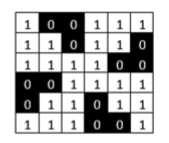A Simple and Effective Edge Detection Algorithm Based on Boolean Logic
Main Article Content
Abstract
Detecting the edges of objects in images is an essential issue in the field of computer vision and image processing, especially in light of the increasing need for immediate and online interaction in determining the content of these images, which requires adopting an appropriate algorithm. This paper introduced a new Simple and Effective Edge Detection (SEED) algorithm. This algorithm relies on Boolean operations to detect edges in binary digital images. SEED analyses every pair of adjacent pixels, horizontally and vertically, in a smoothly and easily manner. This algorithm showed high performance in identifying edges with advanced ability to overcome false edges. To evaluate the SEED algorithm, it has been compared with both the Sobel and Canny algorithms by adopting quantitative evaluation metrics such as the peak signal to noise ratio (PSNR) and the mean square error (MSE), in addition to the intersection-to-union (IoU) ratio index, or what is called Jaccard. The values of the above metrics reected a higher performance of the proposed algorithm. It has been also found that the detection rate of false edges decreased signicantly, making it an effective tool for applications in this field.
Article Details

This work is licensed under a Creative Commons Attribution-NonCommercial-NoDerivatives 4.0 International License.
References
B. Tian and W. Wei, “Research Overview on Edge Detection Algorithms Based on Deep Learning and Image Fusion,” Security and Communication Networks, 2022(Article ID 1155814), 2022.
T. Lu, B. Zhang, Y. Hu, and J. Chen, “Computed Tomography Imaging Based on Edge Detection Algorithm in Diagnosis and Rehabilitation Nursing of Stroke Patients with Motor Dysfunction,” Scientific Programming, 2021(Article ID 5499351), ten pages, 2021.
M. H. Kolekar, Intelligent Video Surveillance Systems: An Algorithmic Approach, Chapman and Hall/CRC. 2018.
Dharampal and V. Mutneja, “Methods of Image Edge Detection: A Review,” Journal of Electrical & Electron Systems, vol. 4, no. 150, 2015.
S. Das S, “Comparison of various edge detection technique,” International Journal of Signal Processing, Image Processing and Pattern Recognition, vol. 9, no. 2, pp. 143-158, 2016.
M. A. Ansari, D. Kurchaniya and M. Dixit, “A Comprehensive Analysis of Image Edge Detection Techniques,” International Journal of Multimedia and Ubiquitous Engineering, vol. 12, no. 11, pp.1-12, 2017.
A. K. Bharodiya and A. M. Gonsai, “An improved edge detection algorithm for X-Ray images based on the statistical range,” Heliyon, vol. 5, no. 10, 2019.
K. M. R. A. Utama, R. Umar, and A. Yudhana, “Edge detection comparative analysis using Roberts, Sobel, Prewitt, and Canny methods,” Journal Teknologi dan Sistem Komputer, vol. 10, no. 2, pp. 67-71, 2022.
Q. Yu, H. Tang, K. C. Tan, and H. Yu, “A braininspired spiking neural network model with temporal encoding and learning,” Neurocomputing, vol. 138, pp. 3–13, 2014.
H. Yedjour, B. Mefta, O. Le ́zoray, and A. Benyettou, “Edge detection based on Hodgkin–Huxley neuron model simulation,” Cognitive Processing, vol. 8, pp. 315–323, 2017.
V. Demin and D.Nekhaev, “Recurrent Spiking Neural Network Learning Based on a Competitive Maximization of Neuronal Activity,” Frontiers in Neuroinformatics, vol. 12, No. 79, 2018.
G. Bellec, D. Sala, A. Subramoney, R. A. Legenstein, and W. Maass, “Long short-term memory and learning-to-learn in networks of spiking neurons,” in Proceedings of the 32nd Conference on Neural Information Processing Systems (NeurIPS 2018), Montreal, QC, Canada, 3–8 December 2018.
K.V. Vemuru, “Image Edge Detector with Gabor Type Filters Using a Spiking Neural Network of Biologically Inspired Neurons,” Algorithms, vol. 13, no. 165, 2020.
H. Wang, B. Yu, K. Xia, J. Li, and X. Zuo, “Skeleton edge motion networks for human action recognition,” Neurocomputing, vol. 423, pp. 1–12, 2021.
S. M. Avendano, D. M. Parra, and O. R. Salguero, “Triangle mesh skeletonization using non-deterministic voxel thinning and graph spectrum segmentation,” MATEC Web of Conf., vol. 336, 2021.
L. Ren, X. Wang, N. Wang, G. Zhang, Y. Li, and Z. Yang, “An edge thinning algorithm based on newly defined single-pixel edge patterns,” IET Image Processing, vol. 17, no.4, pp. 1161-1169, 2023.
X. Li, H. Jiao H., and Y. Wang, “Edge detection algorithm of cancer image based on deep learning,” Bioengineered, vol.11, no. 1, pp. 693-707, 2020.
J. Chen, C. Du, Y. Zhang, P. Han, and W. Wei, “A clustering-based coverage path planning method for autonomous heterogeneous UAVs,” IEEE Transactions on Intelligent Transportation Systems, vol. 23, no. 12, pp. 25546-25556, 2022.
Y. Liu and J. Zhu, “Sub-pixel edge detection algorithm of spot image based on improved Zernike moment,” Laser Journal, vol. 42, no. 5, pp. 32–35, 2021.
H. Un, X. Hao, J. Wang, B. Pan, P. Pei, B. Tai, Y. Zhao, and S. Feng, “Flame Edge Detection Method Based on a Convolutional Neural Network,” ACS Omega, vol. 7, no. 30, pp. 2668026686, 2022.
W. Guohua, S. Zhixiong, H. Min, and Y. Longfei, “Edge detection in single multimode fiber imaging based on deep learning,” Optics Express, vol. 30, no. 17, pp. 30718-30726, 2022.
Y. Jiahao, Z. Li, L. Xiaohui, P. Hong, and W. Jun, “A novel edge detection method based on dynamic threshold neural P systems with orientation,” Digital Signal Processing, vol. 127, Iss. 103526, 2022.
X. Ronghao, L. Rikong, P. Hong, Y. Qian, L. Xiaohui, and W. Jun, “Edge Detection Method Based on Nonlinear Spiking Neural Systems,” International Journal of Neural Systems, vol. 33, no. 1, 2023.
J. Al-Azzeh, B. Zahran, and Z. Alqadi, “Salt and Pepper Noise: Effects and Removal,” International Journal on Informatics Visualization, vol. 2, no. 4, 2018.


